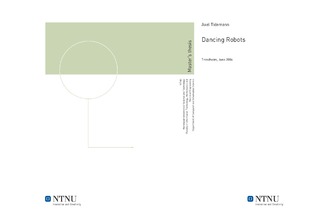| dc.contributor.advisor | Öztürk, Pinar | nb_NO |
| dc.contributor.author | Tidemann, Axel | nb_NO |
| dc.date.accessioned | 2014-12-19T13:34:09Z | |
| dc.date.available | 2014-12-19T13:34:09Z | |
| dc.date.created | 2010-09-05 | nb_NO |
| dc.date.issued | 2006 | nb_NO |
| dc.identifier | 348988 | nb_NO |
| dc.identifier | ntnudaim:1399 | nb_NO |
| dc.identifier.uri | http://hdl.handle.net/11250/251426 | |
| dc.description.abstract | This Master s thesis implements a multiple paired models architecture that is used to control a simulated robot. The architecture consists of several modules. Each module holds a paired forward/inverse model. The inverse model takes as input the current and desired state of the system, and outputs motor commands that will achieve the desired state. The forward model takes as input the current state and the motor commands acting on the environment, and outputs the predicted next state. The models are paired, due to the fact that the output of the inverse model is fed into the forward model. A weighting mechanism based on how well the forward model predicts determines how much a module will influence the total motor control. The architecture is a slight tweak of the HAMMER and MOSAIC architectures of Demiris and Wolpert, respectively. The robot is to imitate dance moves that it sees. Three experiments are done; in the first two the robot imitates another robot, whereas in the third experiment the robot imitates a movement pattern gathered from human data. The pattern was obtained using a Pro Reflex tracking system. After training the multiple paired models architecture, the performance and self-organization of the different modules are analyzed. Shortcomings with the architecture are pointed out along with directions for future work. The main results of this thesis is that the architecture does not self-organize as intended; instead the architecture finds its own way to separate the input space into different modules. This is also most likely attributed to a problem with the learning of the responsibility predictor of the modules. This problem must be solved for the architecture to work as designed, and is a good starting point for future work. | nb_NO |
| dc.language | eng | nb_NO |
| dc.publisher | Institutt for datateknikk og informasjonsvitenskap | nb_NO |
| dc.subject | ntnudaim | no_NO |
| dc.subject | SIF2 datateknikk | no_NO |
| dc.subject | Intelligente systemer | no_NO |
| dc.title | Dancing Robots | nb_NO |
| dc.type | Master thesis | nb_NO |
| dc.source.pagenumber | 143 | nb_NO |
| dc.contributor.department | Norges teknisk-naturvitenskapelige universitet, Fakultet for informasjonsteknologi, matematikk og elektroteknikk, Institutt for datateknikk og informasjonsvitenskap | nb_NO |

